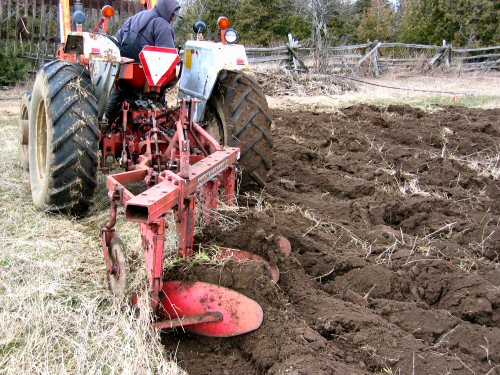
Added a new section to the garden plot today, with a helping hand from Bob, his tractor and a moldboard plow. The moldboard turns the top few inches almost completely over. It’s very effective for breaking up sod, and it’s also sort of an old school approach. Apparently, some farms moldboard once or twice a season, but as a regular practice, it’s not great for the soil and has somewhat fallen from favor in recent years. Here, it’s a one-time plowing that gets the job done!




we are growing around an acre this year on land thats been fallow for years and i wonder how well the moldboard plow would work at knocking out the grass. i think the fellow who is going to come over with his tractor has this attachment, but he was trying to convince us we absolutely had to use roundup which we absolutely would not want to do. then we met with another old timer who said that you can’t roundup until things are green anyhow and seemed to think it wouldn’t be all that much trouble just tilling it up a couple times.
My experience is only with what works with this one hay field, but the principles are pretty straightforward. The main thing is identifying what’s been growing in the “fallow” field. If you have lots of invasive weeds that’ll grow back when they’re chopped up (like quack grass), and you’re committed to not using herbicides, you’ll have to manage your weeds really well for 2-3 years, pulling ’em up, and making sure not to let anything spread crazily or go to seed.
If you use glyphosate (RoundUp, other brands), you have to wait till everything you want to kill is growing, and it’ll kill it all off. The pro argument is that glyphosate is supposed to have no carryover, just vanishes real quick… It’s an easy route, you have to make up your mind if you want to take it, current “science” won’t make your decision for you, a plausible argument could be made based on “proven facts” that RoundUp’s not “bad”. If you’re certified or planning to be, you’re not allowed to do this.
If you’re in a situation like mine, where you don’t use herbicides (and don’t have anything nasty in the field), moldboarding alone works great. The moldboard severs all the longer roots (for me, alfalfa), and practically flips over the top layer, more or less burying the stuff you want to decompose. Then you disk (big metal disks that slice things up) and rototill to break it all up, so decomposition is quick and the texture is good.
If you or your farmer don’t have a rototiller, you could disk two or more times and harrow (kinda like a big stiff comb), and this is probably best done in two parts, coming back maybe a week after the first moldboarding/disking and disking and harrowing again (or start in fall and finish in spring, if it freezes up where you are, that’s good for breaking up newly turned soil as well, what we’ve done until this year). But rototiller in this case is quicker and more efficient. Using a walking rototiller (with two wheels) you could do an acre quick enough, but a tractor-mounted one will go a bit deeper and overall do a better job for this first time.
If you’re spreading manure or compost, the time to do it is after the disking, just before rototilling, which incorporates everything nicely.
The other thing is, if you have a big weed seed population already, from years of weeds going to seed, the seed is still going to be in the soil and viable for years, just waiting to be tilled into the top inch or so to germinate. Regardless of spraying. So one way or another, you’ll have to manage weeds for your first couple of years till you’ve pretty much got things to a level where you’re hopefully not weeding very much at all!!!
Hope that helps!
thanks!
An extra note: If your fallow field has a heavy grass cover, you’re going to have to really chop it up, multiple passes of the disk and rototiller (as I’m doing now!). Even if there’s taller stuff growing, the grass can take over pretty solid down below!! You can check by digging up a square foot or two here and there. If it comes up with the top layer as sheets or big chunks of sod, all matted and held together by grass roots and runners, it’ll be a bit more work in the chopping up department…